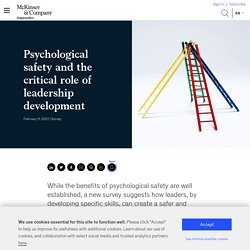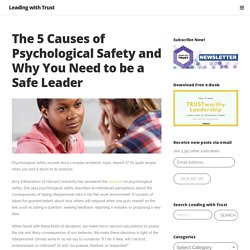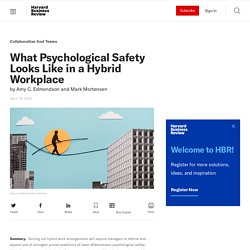

Psychological safety and leadership development. When employees feel comfortable asking for help, sharing suggestions informally, or challenging the status quo without fear of negative social consequences, organizations are more likely to innovate quickly, unlock the benefits of diversity, and adapt well to change—all capabilities that have only grown in importance during the COVID-19 crisis.

Yet a McKinsey Global Survey conducted during the pandemic confirms that only a handful of business leaders often demonstrate the positive behaviors that can instill this climate, termed psychological safety, in their workforce. Audio As considerable prior research shows, psychological safety is a precursor to adaptive, innovative performance—which is needed in today’s rapidly changing environment—at the individual, team, and organization levels. Managers: Compassion and Accountability Aren’t Mutually Exclusive.
Davantage axé sur la compassion, mais certains comportements sont pertinents en matière de sécurité psychologique – savoirspublics
High-Performing Teams Need Psychological Safety. Here’s How to Create It. DH-Psychological Safety: How Pioneers Create Engaged Workforces. Imagine working in a team where it’s safe to take risks—in a team where mistakes are not held against you.

Imagine working with colleagues who can raise tough problems and issues with people who accept others as being different, who feel safe to ask others for help, and who value you and your unique talents. If you recognize yourself (and your team) in this description, you can assume you work in a "psychologically safe" working environment. The concept of psychological safety Back in 1990, William A. Kahn described psychological safety as "being able to show and employ one's self without fear of negative consequences to self-image, status or career. " DH-Psychological Safety: Models and Experiences. Key Takeaways Psychological safety is central to your team and your organization because it is a key factor towards real improvements (high performance).
Les modèles (SAFETY et NETS) me paraissent intéressants. – savoirspublics
We describe and map out using the S.A.F.E.T.Y.

Model and its implications; each of these elements is a source of potential pain, so the knowledge of (or better yet, a personal assessment in) these elements is central to letting you control and revert your bad feelings and behaviours. The 5 Causes of Psychological Safety and Why You Need to be a Safe Leader. Psychological safety sounds like a complex academic topic, doesn’t it?
Pas hyper riche, mais offre une piste d'organisation des dimensions – savoirspublics
It’s quite simple when you boil it down to its essence.

Amy Edmondson of Harvard University has pioneered the research on psychological safety. Outils de santé mentale pour les gestionnaires : Facteur psychosocial 12 - Protection de la sécurité psychologique - EFPC. CSA Standard Z1003 13 Workplace Psychological Health FR. DH-What Psychological Safety Looks Like in a Hybrid Workplace. Sorting out hybrid work arrangements will require managers to rethink and expand one of strongest proven predictors of team effectiveness: psychological safety.

When it comes to psychological safety, managers have traditionally focused on... “Our office policy is that people should come into the office once per week. Now they are organizing a team meeting with 15 people. DH-Pourquoi la sécurité psychologique est-elle la clé de la créativité et de l’innovation sur le lieu de travail. MBL-Quand sécurité psychologique rime avec performance. Workplace Videos Facilitator Guide FR. La psychologie positive Un remède aux angles morts stratégiques. SP- Évaluation du leader psychologiquement sécuritaire Gestionnaire. Sec Psyc Liste références. Soutien politique cadre DRH (2) MBL - Guide d'application de politique cadre.